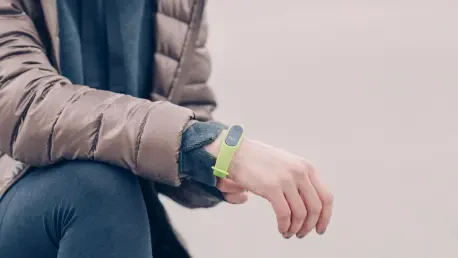In today’s fast-paced, tech-driven world, wearable devices have become indispensable tools for millions seeking to monitor health, stay connected, or simply enhance their daily routines. Whether it’s counting steps during a morning jog, managing notifications without reaching for a phone, or tracking sleep quality to improve rest, the appeal of wearables is undeniable. Yet, with the market brimming with options, the choice between a smartwatch and a fitness band often leaves consumers puzzled. Both promise to elevate lifestyles in unique ways, but they target distinct needs and budgets, making the decision far from straightforward. This exploration aims to break down the critical differences between these two popular gadgets, shedding light on design, functionality, battery performance, cost, and personal fit. By delving into what each device offers, the goal is to provide clarity on which might offer superior value depending on individual priorities. From fitness enthusiasts to busy professionals, understanding these nuances can transform a confusing purchase into a confident one, ensuring the chosen device seamlessly integrates into everyday life.
Striking a Balance: Design and Comfort
When evaluating wearable tech, design and comfort play pivotal roles in determining how well a device fits into daily wear. Smartwatches often stand out with their polished, modern aesthetics, boasting larger, high-resolution touchscreens that double as vibrant displays for apps and notifications. Crafted with premium materials like stainless steel or aluminum, they’re marketed as stylish accessories adaptable to both casual outings and formal settings. Customizable watch faces further enhance their appeal, allowing users to match the device to personal taste. However, this sophisticated design comes with a trade-off: their bulkier build can feel cumbersome during intense activities or prolonged wear, and the power-hungry screens often demand frequent charging. For those who view wearables as an extension of personal style, this blend of fashion and function might outweigh the minor inconveniences of size and maintenance.
Fitness bands, by contrast, take a more utilitarian approach, prioritizing ease and discretion over flashy aesthetics. With slim, lightweight builds and smaller, often monochrome displays, these devices are engineered for all-day comfort, whether during a grueling workout or a night of sleep tracking. Typically made from flexible, skin-friendly materials like silicone, they’re unobtrusive on the wrist, blending into the background rather than drawing attention. This minimalist design ensures they don’t interfere with movement, making them a go-to for active individuals who need a device that stays out of the way. While they may lack the visual flair of smartwatches, their focus on practicality appeals to users who value functionality over form, especially when constant wear is a must for consistent health monitoring.
Core Purpose: Health and Fitness Tracking
A primary reason many invest in wearables is to gain insights into health and activity levels, and here, fitness bands often excel with their laser-focused approach. These devices are built to track essentials like steps, calories burned, heart rate, and detailed sleep patterns with remarkable consistency. Many offer specialized modes for activities such as running, cycling, or swimming, ensuring accurate data for specific workouts. Their extended battery life—often lasting a week or more—means uninterrupted monitoring, which is crucial for users who rely on continuous stats to meet fitness goals. This reliability makes fitness bands a top pick for dedicated athletes or anyone seeking a straightforward tool to maintain an active lifestyle without the distraction of extraneous features.
Smartwatches, while also capable of tracking basic health metrics, aim to provide a more comprehensive suite of insights through advanced sensors. Features like electrocardiogram (ECG) readings, blood oxygen saturation (SpO2) monitoring, and even skin temperature tracking cater to those interested in deeper health data beyond standard activity logs. On-screen workout coaching and detailed analytics displayed on vivid screens further enhance their utility for fitness enthusiasts. However, the trade-off lies in shorter battery life due to power-intensive displays and connectivity, which can disrupt continuous tracking if charging is neglected. For individuals who appreciate a broader health overview and don’t mind a daily charging routine, smartwatches deliver a robust, albeit less consistent, monitoring experience compared to the focused precision of fitness bands.
Beyond Fitness: Smart Features and Connectivity
One of the standout distinctions between these wearables lies in their approach to connectivity and additional functionalities. Smartwatches often serve as miniature extensions of smartphones, offering a suite of features that reduce dependence on a separate device. Capabilities like making and receiving calls, replying to texts with full keyboards or voice input, streaming music, and facilitating contactless payments transform them into powerful communication hubs. This level of integration appeals to tech-savvy users or professionals who need instant access to digital tools without reaching for a phone, making everyday tasks more efficient. The downside is the complexity and power drain that accompany such extensive features, which might overwhelm those seeking simplicity.
Fitness bands, on the other hand, adopt a restrained stance on smart features, focusing instead on minimizing distractions. Most are limited to displaying basic notifications—such as incoming calls, texts, or app alerts—with little to no option for interaction beyond dismissing them or sending preset replies. This stripped-down approach ensures the device remains a tool for health tracking rather than a gateway to digital overload, which can be a significant advantage for users aiming to stay focused during workouts or daily routines. While lacking the standalone capabilities of smartwatches, fitness bands cater to those who prefer a wearable that complements a smartphone rather than competes with it, preserving battery life and maintaining a clear purpose.
Power Play: Battery Life and Maintenance
Battery performance often emerges as a deciding factor when choosing between these devices, as it directly impacts usability and convenience. Fitness bands typically lead the pack with impressive endurance, frequently lasting between 7 to 10 days on a single charge, depending on usage and model. This long-lasting power makes them ideal for travel, outdoor adventures, or simply for those who dislike the hassle of frequent charging. The low-maintenance nature of fitness bands aligns well with active lifestyles, ensuring the device is ready whenever needed without constant attention to power levels. For anyone prioritizing reliability over a packed feature set, this extended runtime often tips the scales in favor of bands.
Smartwatches, burdened by their bright, always-on displays and continuous connectivity features, generally require charging every 24 to 48 hours, akin to the daily ritual of powering up a smartphone. While some models offer quick-charge options to minimize downtime, the need for regular plugging in can be a nuisance for users with packed schedules or limited access to chargers. This trade-off is the cost of accessing advanced functionalities like app integration and real-time notifications, which drain power rapidly. For individuals accustomed to daily device maintenance or those who value the extensive capabilities over uninterrupted runtime, the shorter battery life of smartwatches might be a worthwhile compromise despite the added responsibility.
Cost Considerations: Accessibility vs. Investment
Price remains a critical element in the decision-making process, as it often reflects the scope of features and target audience for each device. Fitness bands are generally positioned as budget-friendly entry points into wearable technology, with many reliable options available at a fraction of the cost of their counterparts. This affordability makes them accessible to a wide range of consumers, from beginners testing the waters of health tracking to seasoned fitness enthusiasts seeking a no-frills tool. The lower price point doesn’t necessarily mean a compromise on core tracking accuracy, making bands an attractive choice for those who want essential functionality without a hefty financial commitment.
Smartwatches, particularly premium models from leading brands, often command a significantly higher price due to their advanced hardware, sophisticated design, and expansive feature sets. This positions them as a substantial investment, tailored to users who plan to leverage the full spectrum of smart capabilities, from communication to entertainment. For individuals who view the device as a central hub for digital interaction and are willing to pay a premium for cutting-edge health sensors and build quality, the cost can be justified. However, for those whose primary focus is fitness tracking without the added bells and whistles, the steep price tag of smartwatches might feel disproportionate to the value gained compared to more economical fitness bands.
Tailored Choice: Aligning with Lifestyle Needs
Selecting the right wearable ultimately hinges on a clear understanding of personal goals and daily demands. For someone deeply invested in fitness, whether an avid runner or a casual walker, a fitness band often provides the most value with its focused tracking, long battery life, and affordable cost. These devices cater to the need for consistent, detailed health data without the distraction of unnecessary features, fitting seamlessly into routines centered on physical activity. Assessing activity levels and the importance of uninterrupted monitoring can guide users toward a band if health metrics are the top priority, ensuring the device supports rather than complicates wellness objectives.
On the flip side, smartwatches tend to resonate with individuals who crave a connected, multi-functional experience, such as professionals managing a busy schedule or tech enthusiasts exploring the latest innovations. The ability to handle calls, messages, and apps directly from the wrist, coupled with advanced health insights, makes them a powerful tool for those juggling multiple responsibilities. Budget considerations and tolerance for daily charging are key factors to weigh, as the higher cost and maintenance demands might not suit everyone. By reflecting on lifestyle patterns—be it the need for digital integration or a preference for simplicity—the decision can be narrowed to the device that truly enhances efficiency and satisfaction in everyday use.
Looking Ahead: Making an Informed Decision
Reflecting on the comparison, it’s evident that both smartwatches and fitness bands have carved out distinct niches in the wearable market over time. Fitness bands have proven to be steadfast companions for those who value simplicity, affordability, and reliable health tracking, delivering consistent performance with minimal upkeep. Smartwatches, meanwhile, have established themselves as dynamic, all-purpose devices that cater to a hunger for connectivity and comprehensive features, even if it means embracing higher costs and shorter battery cycles. The choice between them rests heavily on individual priorities, shaped by lifestyle and specific needs. Moving forward, potential buyers are encouraged to evaluate their primary objectives—whether centered on fitness goals or digital integration—and test devices where possible to gauge comfort and usability. As wearable technology continues to evolve, staying informed about emerging innovations, like hybrid options blending the best of both worlds, can further refine future decisions, ensuring the selected gadget remains a valuable ally in personal growth and productivity.









